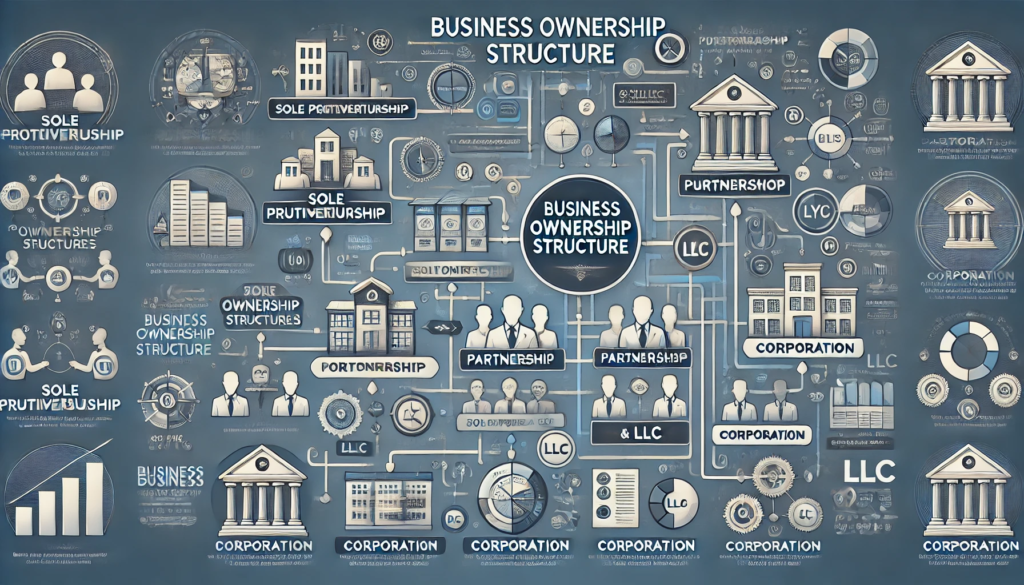
Selecting the right business ownership structure is a crucial decision for business owners. This choice can significantly impact various aspects of the business, including liability, taxation, and operational control. Entrepreneurs must carefully consider their long-term goals, financial resources, and risk tolerance when making this decision. By understanding the different types of business ownership structures and their implications, business owners can make an informed choice that aligns with their vision and objectives. This blog, “What do business owners consider when they select a business ownership structure?” will delve into the key factors business owners consider when determining the most suitable ownership structure for their venture.
What is Business Ownership Structure?

Business ownership structure refers to the legal framework within which a business operates. It determines how a company is organised, how it is taxed, and the level of liability and responsibilities of its owners. Choosing the proper ownership structure is crucial for any business as it impacts various aspects, including legal liability, tax obligations, and operational control. Here are the common types of business ownership structures:
- Sole Proprietorship:
- Description: Owned and operated by one individual.
- Liability: The owner has unlimited personal liability.
- Taxes: Business income is reported on the owner’s personal tax return.
- Partnership:
- Description: Owned by two or more individuals.
- Types:
- General Partnership: All partners share equal responsibility and liability.
- Limited Partnership: This type of partnership includes both general partners (with unlimited liability) and limited partners (with liability limited to their investment).
- Liability: Depends on the type of partnership.
- Taxes: Pass-through taxation where profits and losses are reported on partners’ tax returns.
- Limited Liability Company LLC:
- Description: Combines the benefits of both partnerships and corporations.
- Liability: Owners (called members) have limited liability.
- Taxes: You can choose between pass-through taxation or being taxed as a corporation.
- Corporation:
- Description: A separate legal entity owned by shareholders.
- Types:
- C Corporation: Subject to double taxation (corporate profits and shareholder dividends).
- S Corporation: Pass-through taxation but with restrictions on the number of shareholders.
- Liability: Shareholders have limited liability.
- Taxes: Varies based on the type of corporation.
- Cooperative:
- Description: Owned and operated by individuals for their mutual benefit.
- Liability: Limited liability for members.
What Do Business Owners Consider When They Select a Business Ownership Structure?
Let us explore six key points business owners typically consider when selecting a business ownership structure.
Liability Protection
One of the foremost considerations for business owners is liability protection. This refers to how much personal risk an owner is willing to take on. Different structures offer varying levels of protection.
- Sole Proprietorship and Partnership: These structures do not offer personal liability protection. If the business incurs debt or is sued, the owner’s personal assets (like their home or car) can be at risk.
- Limited Liability Company (LLC) and Corporation: These structures provide liability protection. The business is treated as a separate legal entity, meaning the owners’ personal assets are generally protected from business liabilities.
Business owners often lean towards LLCs or corporations to shield their personal assets from potential business risks.
Tax Implications
Taxes are a significant factor in choosing a business structure. The way a business is taxed can impact the overall profitability and cash flow.
- Sole Proprietorship and Partnership: Profits and losses are passed through to the owner’s personal tax return. This can simplify tax reporting but may lead to higher personal tax rates.
- LLC: Offers flexibility in taxation. An LLC can choose to be taxed as a sole proprietorship, partnership, S-corporation, or C-corporation. This flexibility allows owners to select the most beneficial tax treatment.
- Corporation: Subject to double taxation. The corporation pays taxes on its profits, and shareholders also pay taxes on dividends. However, S-corporations avoid double taxation by allowing profits and losses to pass through to the shareholders’ personal tax returns.
Understanding these tax implications helps business owners optimize their tax obligations and improve their financial health.
Control and Management
The level of control and the way a business is managed varies significantly across different structures. Owners must decide how much control they want to retain and how decisions will be made.
- Sole Proprietorship: The owner has complete control and makes all decisions independently.
- Partnership: Control is shared among partners according to the partnership agreement. It’s crucial to have clear agreements to avoid conflicts.
- LLC: Offers flexibility in management. Owners (members) can manage the business themselves or appoint managers. The operating agreement outlines the management structure.
- Corporation: Managed by a board of directors elected by shareholders. This can lead to less direct control for individual owners, but it’s suitable for larger businesses with multiple shareholders.
Business owners must consider how they want to structure control and management to ensure smooth operations and alignment with their business goals.
Ease of Formation and Ongoing Administration
The complexity and cost of forming and maintaining a business structure also play a crucial role in the decision-making process. Some structures are easier and cheaper to establish and maintain than others.
- Sole Proprietorship: The simplest and least expensive to establish. Requires minimal paperwork and no formal filings.
- Partnership: Requires a partnership agreement but is relatively simple to establish. Costs are low, but it’s essential to have a clear agreement to outline each partner’s responsibilities.
- LLC: More complex and expensive to establish than a sole proprietorship or partnership. Requires filing articles of organization and drafting an operating agreement.
- Corporation: The most complex and expensive to establish and maintain. Requires filing articles of incorporation, creating bylaws, and holding regular board meetings.
Business owners must weigh the ease of formation and the administrative burden against the benefits provided by each structure.
Ability to Raise Capital
Raising capital is crucial for business growth. The chosen ownership structure can significantly impact the ability to attract investors and secure funding.
- Sole Proprietorship: Limited ability to raise capital. Owners rely on personal savings, loans, or reinvested profits.
- Partnership: Easier to raise capital than sole proprietorships, as partners can pool resources and attract investors who prefer to deal with multiple owners.
- LLC: More attractive to investors than sole proprietorships or partnerships due to limited liability protection and flexible profit distribution.
- Corporation: The most favorable structure for raising capital. Corporation advantages includes issue of stocks to attract investors. Public corporations can also list on stock exchanges to access a broader investor base.
Business owners must consider their future capital needs and choose a structure that aligns with their growth plans.
Future Needs and Flexibility
Lastly, business owners should consider the long-term needs and flexibility of the ownership structure. Businesses evolve, and the chosen structure should accommodate future changes.
- Sole Proprietorship: Limited flexibility. The business is tied to the owner, making it difficult to transfer ownership or bring in new partners.
- Partnership: More flexible than sole proprietorships but still challenging to transfer ownership without dissolving the partnership.
- LLC: Offers significant flexibility. Owners can easily add new members, change management structures, or convert to a corporation if needed.
- Corporation: Highly flexible. Ownership can be transferred through the sale of stocks, and the structure can support substantial growth and expansion.
Choosing a structure that can adapt to changing circumstances helps ensure the business’s longevity and success.
Conclusion
Selecting the right business ownership structure is a critical decision that affects various aspects of a business, from liability and taxes to control and the ability to raise capital. By carefully considering liability protection, tax implications, control and management, ease of formation and ongoing administration, ability to raise capital, and future needs and flexibility, business owners can make informed decisions that set their ventures up for success. Each business is unique, and it’s essential to choose a structure that aligns with the specific goals, resources, and circumstances of the business.








No Comments